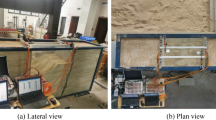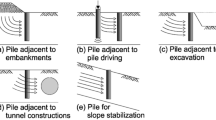Abstract
In a recent study, the time-dependent increase in axial load resistance of steel H-piles driven into cohesive soils, due to setup, was systematically quantified using measured field data. A method to estimate the setup based on measurable soil properties was subsequently established. These studies highlighted that the uncertainties of the measurements of soil properties and thus the semi-empirical approach to estimate setup are significantly different from those of the methodology used for measuring the pile resistance during retaps at any time after the end of driving. Recognizing that the two sets of uncertainties should be addressed concurrently, this paper presents a procedure for determining the factored resistance of a pile with due consideration to setup in accordance with the load and resistance factor design that targets a specific reliability index. Using the first-order second-moment method, the suggested procedure not only provides a simplified approach to incorporate any form of setup in design, but it also produces comparable results to the computationally intensive first-order reliability method. Incorporating setup in design and construction control is further shown to reduce foundation costs and minimize retap requirements on piles, ultimately reducing the construction costs of pile foundations.







Similar content being viewed by others
References
Abu-Farsakh MY, Yoon SM, Tsai C (2009) Calibration of resistance factors needed in the LRFD design of driven piles. Report FHWA/LA.09/449, Federal Highway Administration, U.S. Department of Transportation, Washington, DC
American Association of State Highway and Transportation Officials (AASHTO) (2003) LRFD bridge design specifications 2nd edition, 1998 with 2003 Interim. American Association of State Highway and Transportation Officials, Washington, DC
American Association of State Highway and Transportation Officials (AASHTO) (2012) LRFD bridge design specifications, 6th edn. American Association of State Highway and Transportation Officials, Washington, DC
Anderson TW, Darling DA (1952) Asymptotic theory of certain “goodness-of-fit” criteria based on stochastic processes. Ann Math Stat 23:193–212
Barker R, Duncan J, Rojiani K, Ooi P, Tan C, Kim S (1991) Manuals for the design of bridge foundations. NCHRP report 343, Transportation Research Board, Washington, DC
Bloomquist D, McVay M, Hu Z (2007) Updating Florida Department of Transportation’s (FDOT) pile/shaft design procedures based on CPT & DTP data. Final report, UF Project #00005780, University of Florida, Gainesville, FL
Bullock PJ, Schmertmann JH, McVay MC, Townsend FC (2005) Side shear setup I: test piles driven in Florida. J Geotech Geoenv Eng ASCE 131(3):292–300
Davisson M (1972) High capacity piles. In: Proceeding of soil mechanics lecture series on innovations in foundation construction, ASCE, IL Section, Chicago, IL, pp 81–112
Fellenius BH (2002) Pile dynamics in geotechnical practice-six case histories. In: O’Neill MW, Townsend FC (eds) Geotechnical special publication no. 116, deep foundations 2002. ASCE, Reston, VA, pp 619–631
Fenton GA, Griffiths DV (2008) Risk assessment in geotechnical engineering. Wiley, Hoboken, NJ
Huang S (1988) Application of dynamic measurement on long H-pile driven into soft ground in Shanghai. In: Fellenius BH (ed) Proceedings of 3rd international conference on the application of stress-wave theory to piles, Ottawa, Ontario, Canada, pp 635–643
Kolmogorov A (1933) Sulla determinazione empirica di una legge di distribuzione. Giorn. dell’Istit. Degli att 4:83–91
Komurka VE, Winter CJ, Maxwell S (2005) Applying separate safety factors to end-of-drive and set-up components of driven piles capacity. In: Geotechnical applications for transportation infrastructure, Proceedings of the 13th Great Lakes Geotechnical and Geoenvironmental Conference, Milwaukee, WI, pp 65–80
Long JH, Maniaci M, Samara EA (2002) Measured and predicted capacity of H-piles. In: O’Neill MW, Townsend FC (eds) Geotechnical special publication no. 116, deep foundations 2002. ASCE, Reston, VA, pp 542–558
Lukas RG, Bushell TD (1989) Contribution of soil freeze to pile capacity. In: Foundation engineering: current principles and practices, vol 2, pp 991–1001
Ng KW, Suleiman TM, Roling M, AbdelSalam SS, Sritharan S (2011) Development of LRFD design procedures for bridge piles in Iowa—volume II: field testing of steel piles in clay, sand, and mixed soils and data analysis. Final Report, IHRB Project No. TR-583. Institute for Transportation, Iowa State University, Ames, IA
Ng KW, Sritharan S, Dunker KF, Danielle D (2012) Verification of recommended load and resistance factor design approach to piles in cohesive soils. Journal of Transportation Record, Volume 2310, Transportation Research Board, Washington, DC, pp 49–58
Ng KW, Roling M, AbdelSalam SS, Sritharan S, Suleiman MT (2013) Pile setup in cohesive soil. I: experimental investigation. J Geotech Geoenv Eng ASCE 139(2):199–209
Ng KW, Suleiman MT, Sritharan S (2013) Pile setup in cohesive soil. II: analytical quantifications and design recommendations. J Geotech Geoenv Eng ASCE 139(2):210–222
Nowak A (1999) Calibration of LRFD bridge design code. NCHRP Report 368, Transportation Research Board, Washington, DC
Paikowsky SG, Birgisson B, McVay M, Nguyen T, Kuo C, Baecher G, Ayyab B, Stenersen K, O’Malley K, Chernauskas L, O’Neill M (2004) Load and resistance factor 0 design (LRFD) for deep foundations. NCHRP Report 507, Transportation Research Board, Washington, DC
Randolph MF, Carter JP, Wroth CP (1979) Driven piles in clay—the effects of installation and subsequent consolidation. Geotechnique 29(4):361–393
Roling MJ, Sritharan S, Suleiman MT (2011) Introduction to PILOT database and establishment of LRFD resistance factors for the construction control of driven steel H-piles. J Bridge Eng ASCE 16(6):728–738
Skov R, Denver H (1988) Time-dependence of bearing capacity of piles. In: Fellenius BH (ed) Proceedings of the 3rd international conference on the application of stress-wave theory to piles, Ottawa, Ontario, Canada, pp 879–888
Soderberg LO (1962) Consolidation theory applied to foundation pile time effects. Geotechnique 12(3):217–225
Svinkin MR, Skov R (2000) Set-up effect of cohesive soils in pile capacity. In: Niyama S, Beim J (eds) Proceedings of the 6th international conference on application of stress-waves theory to piles, Sao Paulo, Brazil, pp 107–111
Yang L, Liang R (2006) Incorporating set-up into reliability-based design of driven piles in clay. Can Geotech J 43(9):946–955
Acknowledgments
The authors would like to thank the Iowa Highway Research Board for sponsoring the research presented in this paper.
Author information
Authors and Affiliations
Corresponding author
Appendix: Derivation of the resistance factor for setup
Appendix: Derivation of the resistance factor for setup
Satisfying the lognormal distributions and independent relationships of loads and resistances, the reliability index (β) is expressed as a ratio of mean to standard deviation of the limit state function (g), which can be expanded as follows:
where R EOD is the pile resistance at EOD, R setup is the pile setup resistance, E(g) is the expected value of the limit state function g, σ g is the standard deviation of the limit state function g, E(ln(R EOD)) is the expected value of the natural logarithm of the pile resistance at EOD, and σ ln(REOD) is the standard deviation of the natural logarithm of the pile resistance at EOD, which can be similarly defined for other random variables. To express Eq. (11) in terms of simple means (i.e., \( \overline{R} \) and \( \overline{Q} \)) and coefficients of variation (COV) for resistances and loads of the normal distributions, the mean and standard deviation of a lognormal distribution for any resistance or load can be transformed using the following general expressions:
Using these expressions for the three random variables (R EOD, R setup, and Q) and substituting them into Eq. (11), the reliability index can be expressed as follows:
Replacing the simple mean values with their respective bias factors (λ), a ratio between average measured and predicted values (i.e., R m/R or Q m/Q), and neglecting the terms that involve multiplying two squared coefficients of variation (i.e., COV2COV2) since their contribution would be insignificantly small, the expression for β is simplified as:
using the LRFD strength limit state equation (γQ = φR) and replacing φR with φ EOD R EOD + φ setup R setup, the equation can be rearranged for R setup as:
substituting Eq. (16) into Eq. (15) and isolating the φ setup as the variable of interest by rearranging, a preliminary equation for φ setup can be established as follows:
considering only the dead (Q D) and live (Q L) loads, as per the AASHTO [3] “Strength I” load combination, the factored load (γQ) and bias load (λ Q Q) are expanded to:
As defined in AASHTO [3], γ D is the dead load factor of 1.25, γ L is the live load factor of 1.75, λ D is the dead load bias of 1.05, and λ L is the live load bias of 1.15. Furthermore, the coefficient of variation of the load (COV Q ), derived by Bloomquist et al. [6], in terms of dead and live load components is given as:
substituting Eqs. [18], [19], and [20] into Eq. (17), the φ setup can be revised as:
Normalizing the above expression with respect to the total load (Q D + Q L), and further rearrangement of Eq. (21) in terms of the dead load to live load ratio (i.e., Q D/Q L) and representing α as the ratio of pile resistance at EOD to the total load (i.e., α = R EOD/[Q D + Q L]), the resistance factor of pile setup at a target reliability index (β T ) can be expressed as:
The parameter α, a ratio of pile resistance at EOD to total load, noted above is analogous to a safety factor applied to the R EOD if the traditional allowable stress design (ASD) approach would have been considered. The uncertainties associated with R EOD have been accounted for in terms of φ EOD in Eq. (22) to comply with the LRFD approach. Since the uncertainties were addressed, the parameter α is suggested as unity in order to eliminate the redundancy in the safety margin applied to R EOD, and the resistance factor for pile setup based on the FOSM method can be expressed as:
Rights and permissions
About this article
Cite this article
Ng, K.W., Sritharan, S. A procedure for incorporating setup into load and resistance factor design of driven piles. Acta Geotech. 11, 347–358 (2016). https://doi.org/10.1007/s11440-014-0354-8
Received:
Accepted:
Published:
Issue Date:
DOI: https://doi.org/10.1007/s11440-014-0354-8




